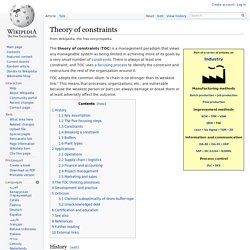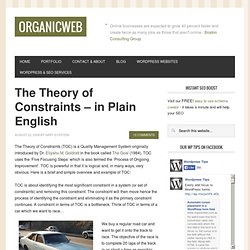Zoom
Trash

Event chain methodology. Event chain diagram Event chain methodology is an uncertainty modeling and schedule network analysis technique that is focused on identifying and managing events and event chains that affect project schedules.

Event chain methodology is the next advance beyond critical path method and critical chain project management.[1] Event Chain Methodology Principles[edit] Moment of risk and state of activity[edit] Moment of risk and state of activity An activity (task) in most real life processes is not a continuous uniform procedure. One of the important properties of an event is the moment when an event occurs during the course of an activity. Event Chains[edit] Events can cause other events, which will create event chains. Monte Carlo Simulations[edit] Once events and event chains are defined, quantitative analysis using Monte Carlo simulation can be performed to quantify the cumulative effect of the events. Critical Chain Project Management. Critical chain project management (CCPM) is a method of planning and managing projects that emphasizes the resources required to execute project tasks.

It was developed by Eliyahu M. Goldratt. It differs from more traditional methods that derive from critical path and PERT algorithms, which emphasize task order and rigid scheduling. A critical chain project network strives to keep resources levelly loaded, but requires that they be flexible in start times, and quickly switch between tasks and task chains to keep the project on schedule. Origins[edit] According to studies of traditional project management methods by Standish Group and others as of 1998, only 44% of projects typically finish on time. Details[edit] Critical Chain Project Management Overview Theory of Constraints Projects Critical Chain. Critical Chain Project Management – A Performance Engine For Projects Critical Chain Project Management is the Theory of Constraints logistical application for project operations.

It is named after the essential element; the longest chain of dependent resourced tasks in the project. The aim of the solution is to protect the duration of the project, and therefore completion date, against the effects of individual task structural and resource dependency, variation, and uncertainty. The outcome is a robust and dependable approach that will allow us to complete projects on-time, every time, and most importantly within at most 75% of the current duration for single projects and considerably less for individual projects within multi-project environments. The shorter duration provides a sterling opportunity in the marketplace to differentiate ourselves from our competitors who deliver poorer outcomes, and late at that, via other project management methods. Our Plan Of Attack Identify Exploit. Theory of Constraints. The theory of constraints (TOC) is a management paradigm that views any manageable system as being limited in achieving more of its goals by a very small number of constraints.

There is always at least one constraint, and TOC uses a focusing process to identify the constraint and restructure the rest of the organization around it. TOC adopts the common idiom "a chain is no stronger than its weakest link. " This means that processes, organizations, etc., are vulnerable because the weakest person or part can always damage or break them or at least adversely affect the outcome. History[edit] An earlier propagator of the concept was Wolfgang Mewes[2] in Germany with publications on power-oriented management theory (Machtorientierte Führungstheorie, 1963) and following with his Energo-Kybernetic System (EKS, 1971), later renamed Engpasskonzentrierte Strategie as a more advanced theory of bottlenecks.
Key assumption[edit] TOC Journey. Theory of Constraints.ppt. Theory of Constraints Basics. The Theory of Constraints (TOC) is a Quality Management System originally introduced by Dr.

Eliyahu M. Goldratt in the book called The Goal (1984). TOC uses the ‘Five Focusing Steps’ which is also termed the ‘Process of Ongoing Improvement’. TOC is powerful in that it is logical and, in many ways, very obvious. Here is a brief and simple overview and example of TOC: TOC is about identifying the most significant constraint in a system (or set of constraints) and removing this constraint. We buy a regular road car and want to get it onto the track to race. 1) The car is reliable and working fine however engine parts are expensive when required. 2) The car needs to be registered to race. 3) The car needs to be repainted. What is the biggest constraint listed above? TOC was originally designed for improving manufacturing processes however has been adapted and successfully used in many industries including; Marketing, Service Industries and Information Technology.